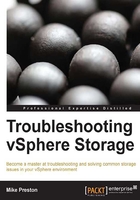
Storage naming
In order to begin troubleshooting vSphere Storage, we need to be aware of how vSphere identifies and names the storage devices, LUNs, and paths available to our hosts. During the process of troubleshooting of vSphere Storage, there are a lot of situations where we need to provide the identifier of a storage device or path in order to obtain more information about the issue. Due to the uniqueness of these identifiers, ESXi will often use them when logging issues to syslog.
Viewing device identifiers
We are able to view device identifiers in a couple of different places; within the vSphere Client and within the ESXi Shell. Let us have a look at each in turn.
Within the vSphere Client
We can view the device identifiers within the vSphere Client by performing the following steps:
- Click on the Configuration tab of the host whose storage you wish to view.
- Click on the Storage section under Hardware.
- Switch to the Devices view and right-click on the header bar to add and remove desired columns if needed.

Device identifiers from the vSphere Client
Within ESXi Shell
The following command will give us similar information as to what we see in the vSphere Client and should return similar information to that of the following screenshot:
esxcfg-scsidevs –c

Device identifiers from within the vSphere CLI
The many ways vSphere identifies storage
As shown in the previous two screenshots, we can see that there are three different identifiers as it pertains to storage naming: friendly names, identifiers, and runtime names.
Friendly names
Friendly names are generated by the host and can be modified and defined by the administrator.
Identifiers
Identifiers are not user definable due to the sheer fact that they must be unique and persistent in the case of a host reboot. Identifiers are displayed in one of many different formats which are derived depending on the storage subsystem presenting the device. In the previous two screenshots, you can see a variety of identifiers are used.
NAA identifiers
A large majority of storage devices return NAA identifiers which all begin with "naa.". An NAA identifier is often compared to that of a MAC address on a NIC as it is defined by certain standards and is always unique to the device being presented.
T10 identifiers
Another type of identifier shown is called a T10 identifier and always begins with "t10.". Normally, T10 identifiers are associated with an iSCSI array; however, it could be returned from any SCSI device. T10 identifiers are also governed by standards and like NAA identifiers, should always be unique.
IQN identifiers
Another identifier type which is solely used on iSCSI arrays is an iSCSI Qualified Name (IQN). IQNs are normally user configurable on the iSCSI arrays which in turn does not guarantee uniqueness on a global scale, but we should always ensure we have uniqueness within our environment. IQNs will always begin with "iqn." and just like NAA and T10 identifiers, must be persistent across reboots. Even if your iSCSI array is using IQN, there are times when it will return a T10 identifier, or a mixture of T10 and IQN identifiers.
MPX identifiers
The last type of identifier we can see in the previous two screenshots is an MPX identifier. MPX (VMware Multipath X Device) identifiers are generated by the ESXi host when the device does not return a naa, T10, or IQN identifier, and always begin with "mpx.". Unlike the other industry standard identifiers, MPX is not globally unique and is not persistent during a reboot. Normally, MPX identifiers are only seen on devices such as a CD or DVD ROM as they usually do not respond with any industry standard identifier.
Runtime names
Runtime names basically describe the first path to the device as assigned by the host. Although these usually don't change, there is no guarantee that they will persist across reboots since we cannot guarantee that a certain path to a storage device will always be active. Runtime names are constructed using the format shown in the following table:

As you can conclude from the above description, the device described in the previous two screenshots with the identifier naa.600508b4000e21340001400000260000 exists on vmhba1, channel 0, target 0, and LUN 8, and therefore has a runtime name of vmhba1:C0:T0:L8.
Since friendly names are user definable and runtime names are not persistent across reboots or rescans, we will normally use the naa, t10, or IQN identifier when accessing and troubleshooting storage. It's the only form of storage naming that provides us the persistence and uniqueness that we need to ensure we are dealing with the proper datastore or path.